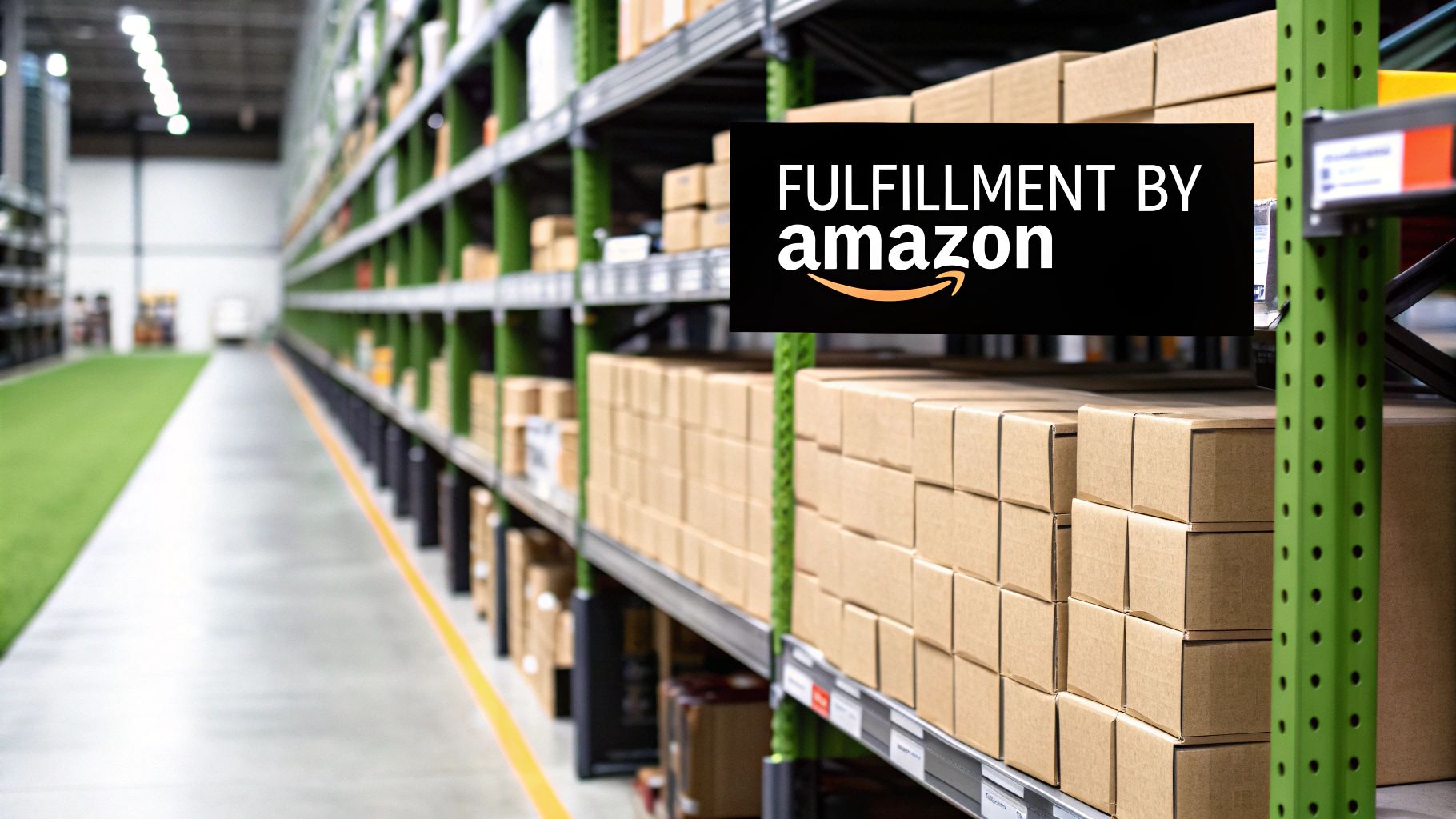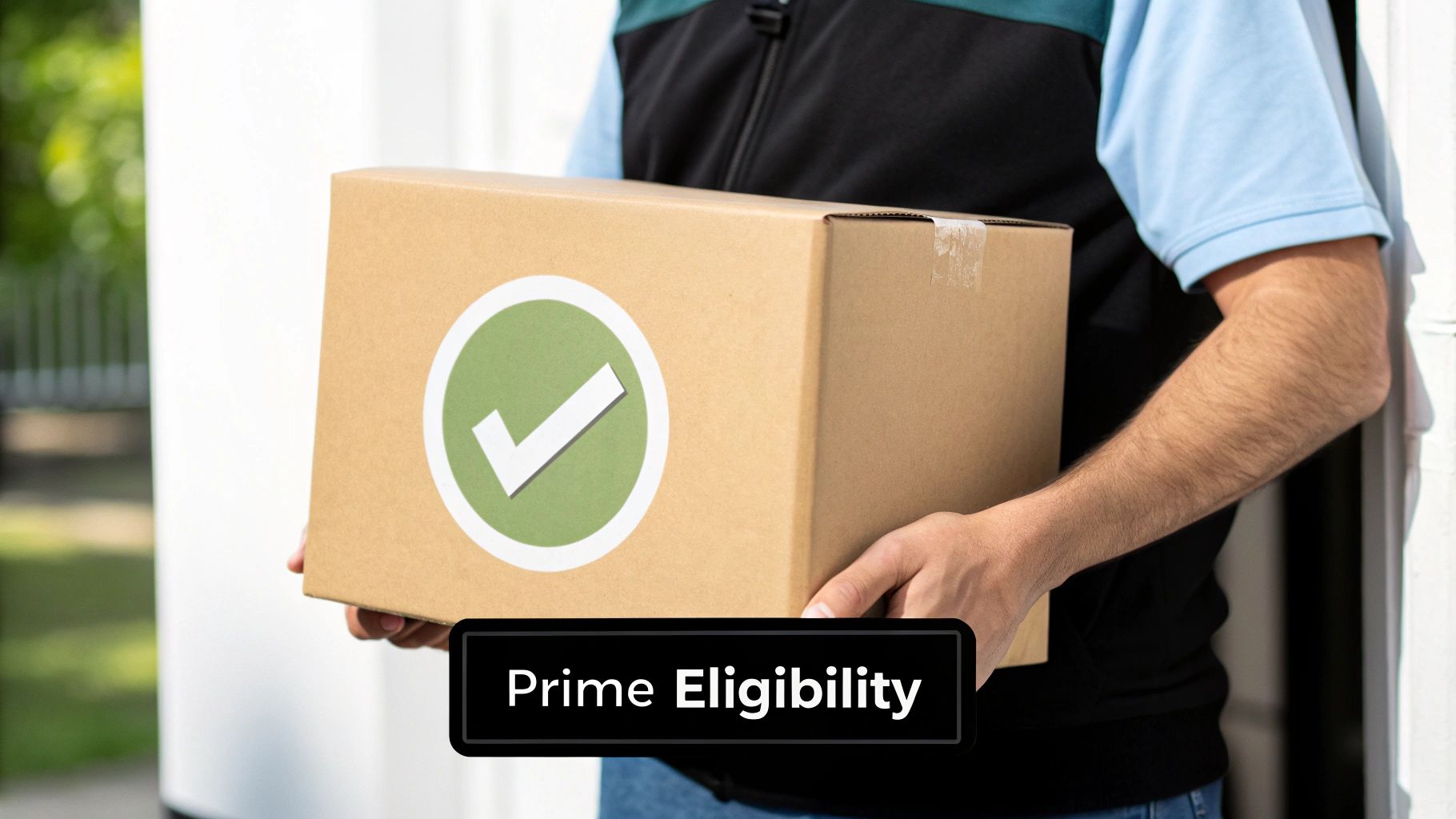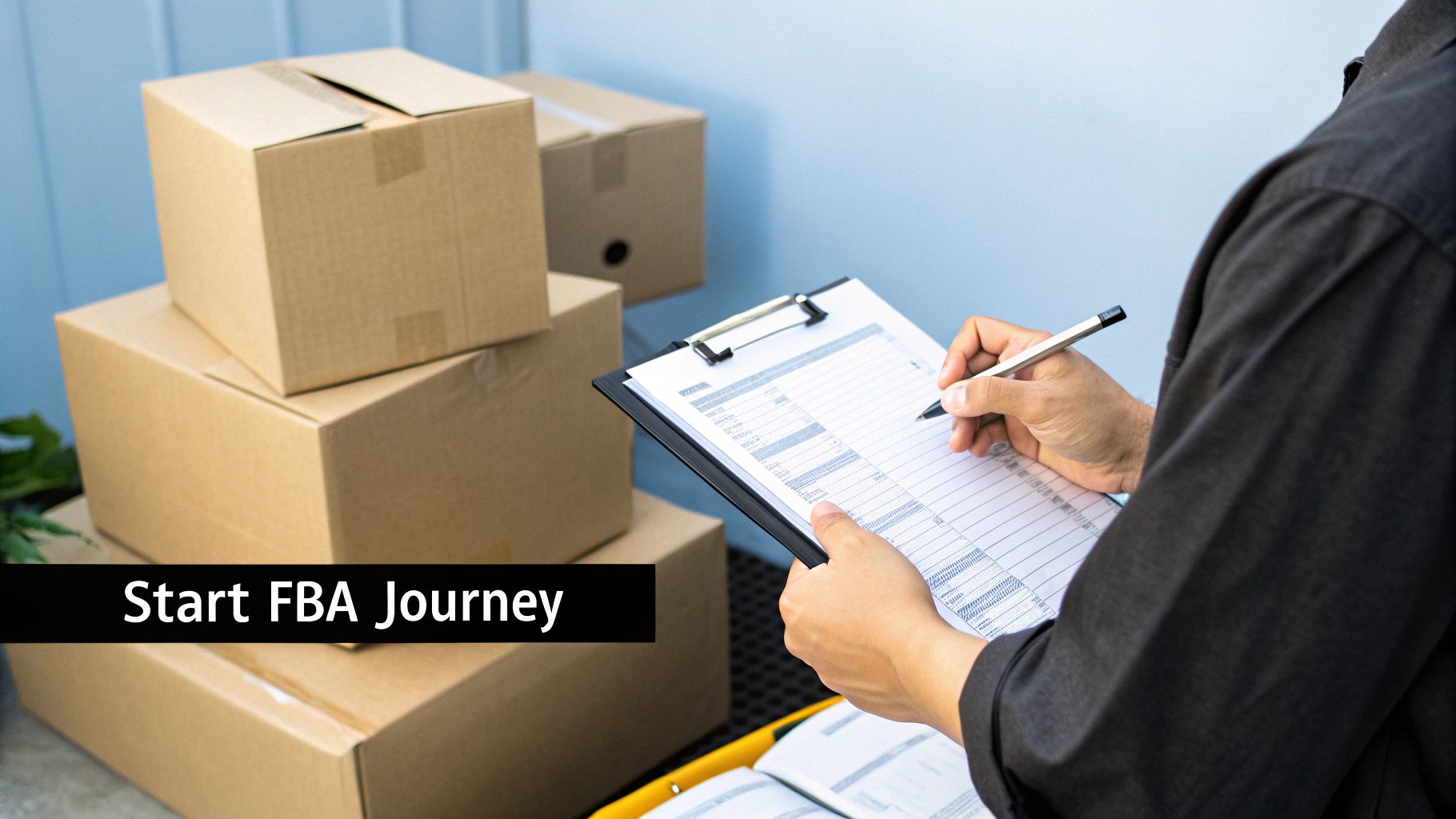So, what is this Fulfillment by Amazon (FBA) thing everyone talks about? In short, it’s a service that lets you hand off all your order fulfillment—the storing, packing, and shipping—to Amazon’s massive logistics network.
Instead of turning your garage into a mini-warehouse, you just send your products to an Amazon fulfillment center. They take it from there.
How The FBA Process Actually Works
Imagine your business is booming. Awesome! But now you’re spending all day packing boxes, printing labels, and running to the post office. That’s a huge time suck. FBA is your ticket out of that grind, freeing you up to focus on the things that actually grow your business, like marketing and product development.
The whole thing is surprisingly simple:
- You Send Your Products to Amazon: First, you prep your products based on Amazon's guidelines and ship them off to one of their fulfillment centers.
- Amazon Stores Your Inventory: Once your stuff arrives, Amazon scans it and stores it in their gigantic warehouses, ready to go as soon as an order comes in.
- A Customer Places an Order: Someone buys your product on Amazon. The second they click "buy," Amazon’s system gets to work.
- Amazon Picks, Packs, and Ships: Their team finds your item on the shelf, packs it into one of those familiar Amazon boxes, and ships it directly to the customer.
- Amazon Handles Customer Service and Returns: FBA also includes 24/7 customer service for the orders they fulfill. If a customer has a question or needs to make a return, Amazon handles that too, which gives buyers a lot more confidence.
This hands-off model is a game-changer and has become a core strategy for sellers across all sorts of digital marketplaces. Amazon's own graphic breaks down this beautifully simple workflow.

As you can see, it’s a clean cycle: you send inventory, Amazon stores it, and then they handle the rest when an order comes through. The simplicity of it all is precisely why FBA is the go-to method for millions of sellers.
Fulfillment by Amazon is used by a staggering 82% of active sellers on the platform. With over 2.5 million sellers globally, this means more than 2 million businesses trust Amazon to handle their logistics. This isn't some niche service; it's the standard for a reason. Its high adoption rate speaks volumes about how effective and reliable it is for e-commerce businesses of all sizes.
The Strategic Advantages of Using FBA

Choosing Fulfillment by Amazon is about more than just outsourcing your shipping. It's a strategic move that can completely change your business's trajectory by unlocking some serious competitive advantages. The biggest and most immediate of these is getting the coveted Amazon Prime badge.
That little logo instantly puts your products in front of millions of Amazon’s most loyal, ready-to-buy customers. Prime members are hardwired to look for that badge because it signals the fast, free shipping they’ve come to expect and trust. Gaining that visibility can give your conversion rates a massive boost.
Beyond the badge, you’re plugging into Amazon's colossal and ruthlessly efficient logistics network. We're talking about an infrastructure built for speed and reliability that most individual sellers could never hope to build on their own.
Tapping Into World-Class Operations
When you leverage FBA, you’re not just a small business anymore. You're backed by one of the most advanced fulfillment operations on the planet. This translates into real, tangible benefits that hit your bottom line and keep your customers happy.
- 24/7 Customer Service: Amazon's team fields all customer questions, order issues, and returns for your FBA products. That alone saves you countless hours of headaches.
- Trusted Shipping and Returns: Customers know and trust the Amazon process. That familiarity reduces hesitation at checkout and makes them more confident clicking "buy now."
- Focus on Growth: By handing off the operational heavy lifting, you can finally redirect your energy to what really matters: sourcing new products, marketing your brand, and analyzing sales data.
Essentially, FBA frees you up to be a business owner, not a warehouse manager. This shift is what separates the brands that scale from those that get stuck. For a deeper look into this, our guide on how to improve Amazon sales breaks down how fulfillment ties into your overall strategy.
The numbers don't lie. Studies consistently show FBA sellers see a sales lift of 20–25% compared to merchants handling their own fulfillment. Amazon’s fulfillment centers are so strategically placed they can reach 67% of the U.S. population with same-day or next-day delivery—a speed that builds incredible customer loyalty. You can find more insights on FBA’s impact on sales on amzprep.com.
Navigating the Costs of Amazon FBA
While the convenience of FBA is a massive perk, it’s not free. Amazon operates on a pay-as-you-go model, and getting a handle on the costs is absolutely critical if you want to turn a profit.
The easiest way to think about FBA fees is to break them down into two main buckets that every single seller will deal with.
First, you have fulfillment fees. You might hear these called "pick and pack" fees. This is a flat, per-unit cost that covers the entire journey of getting an order into your customer's hands—from an Amazon employee finding the item on a shelf, boxing it up, and shipping it out the door.
Next up are the monthly inventory storage fees. This one is pretty straightforward: it’s the rent you pay for the physical space your products take up in Amazon's massive warehouses. It’s calculated based on volume (cubic feet), so bigger, bulkier items will cost more to store.
Breaking Down the Main FBA Fees
So, what determines the price tag on those two core fees? It all comes down to your product's size and weight. Amazon sorts products into specific size tiers—like small standard, large standard, and a few different levels of oversize—and these tiers directly dictate what you'll pay for both fulfillment and storage.
A small, light item like a phone case is going to have much, much lower fees than something bulky like a toaster oven. It takes up less shelf space and is cheaper to ship. Simple as that. You can find detailed fee charts right inside Seller Central to calculate these costs before you ever ship your inventory to Amazon.
It's essential to realize that FBA fees are not static. For instance, storage fees increase during the peak holiday season from October to December, reflecting the higher demand for warehouse space. Planning for this seasonal adjustment is key to protecting your margins.
Other Potential FBA Costs to Consider
Beyond those two main fees, a few other costs can pop up depending on how you manage your inventory. Staying on top of these will help you avoid nasty surprises that can chew through your profits.
- Long-Term Storage Fees: If your products sit around for too long (usually over 181 days), Amazon will start charging extra. This is their way of encouraging sellers to keep inventory moving and not treat warehouses like a long-term storage unit.
- Removal Order Fees: Need to pull unsold inventory out of FBA and have it sent back to you? There’s a per-item fee for that, which covers the cost for Amazon to process the removal.
- Returns Processing Fees: While Amazon handles the entire returns process for you (a huge time-saver!), they do charge a small processing fee for returns in certain categories, like apparel.
Don’t forget that on top of Amazon's fees, FBA sellers have the same financial responsibilities as any other business. Understanding your essential small business tax deductions can make a huge difference to your bottom line. Getting a firm grip on all these costs is a fundamental part of making FBA work for you.
To give you a clearer picture, let's look at how fees can differ based on a product's size.
Amazon FBA Fee Structure Example
| Fee Type | Standard-Size Product Example | Oversized Product Example |
|---|---|---|
| Fulfillment Fee | $3.86 (e.g., small book) | $18.51 (e.g., microwave oven) |
| Monthly Storage (Jan-Sep) | $0.02 per unit (approx.) | $3.63 per unit (approx.) |
| Monthly Storage (Oct-Dec) | $0.05 per unit (approx.) | $5.20 per unit (approx.) |
As you can see, the jump in costs between a standard and an oversized item is significant. This is why product selection is so crucial—your margins can shrink fast if you're not accounting for these fee differences.
Choosing Between FBA and FBM for Your Business
While FBA is a powerhouse, it’s not the only game in town. The main alternative is Fulfillment by Merchant (FBM), the do-it-yourself model where you’re in the driver's seat for storing, packing, and shipping every order.
Deciding between the two really boils down to your products, your business goals, and what you’re realistically able to handle.
FBA is a no-brainer for sellers who want to be as hands-off as possible with logistics. If you're moving high volumes of standard-sized products and want that irresistible Prime badge to boost sales, FBA is almost always the way to go. It lets you scale up fast without needing to build out your own warehouse.
But FBM offers a level of control and flexibility that FBA simply can't match.
When FBM Makes More Sense
This model can be far more profitable for sellers in specific situations. You’ll probably lean toward FBM if you sell:
- Oversized or Heavy Items: FBA fees for big, bulky products can demolish your profit margins. Handling fulfillment yourself is often a much more cost-effective route.
- Niche or Slow-Moving Products: If your inventory turns over slowly, FBM helps you sidestep Amazon's long-term storage fees, which can really add up.
- Products Requiring Special Packaging: FBM gives you total control over branding and the customer's unboxing experience—a critical factor for building a memorable brand.
This decision tree gives you a quick visual on which path might be the right fit based on a few key factors.

As the graphic shows, high order volume is a strong signal for FBA, mainly for that Prime eligibility. But with lower volume, the size of your product becomes a much more important consideration. Making the right call here demands a clear-eyed look at your margins, sales velocity, and long-term strategy. To get a better handle on where you stand, our marketplace evaluation test can be a huge help in assessing your business needs.
To make it even clearer, let's break down the core differences in a side-by-side comparison.
FBA vs FBM At a Glance
| Feature | Amazon FBA (Fulfillment by Amazon) | FBM (Fulfillment by Merchant) |
|---|---|---|
| Inventory Storage | Stored in Amazon's fulfillment centers. | You store it yourself (warehouse, home, etc.). |
| Order Packing & Shipping | Amazon handles all picking, packing, and shipping. | You handle all picking, packing, and shipping. |
| Customer Service & Returns | Managed by Amazon's 24/7 customer service. | You manage all customer service and returns. |
| Prime Eligibility | Products are automatically Prime-eligible. | Eligible only through Seller Fulfilled Prime (SFP). |
| Control Over Branding | Limited control over packaging and branding. | Full control over the unboxing experience. |
| Best For | High-volume, standard-sized items; sellers who want to scale quickly and be hands-off. | Oversized, slow-moving, or specialty items; sellers who want maximum control and lower fees. |
Ultimately, both models have their place. It’s about matching the fulfillment method to your business reality.
Key Takeaway: The FBA vs. FBM debate isn't about which one is "better," but which is better for you. FBA is built for convenience, speed, and getting that Prime badge. FBM is all about control, customization, and dodging certain fees. Analyze your products and your operational strengths before you lock yourself into one path.
Your First Steps to Launching with FBA

Alright, enough with the theory. Let's get your products into Amazon's hands. Launching with FBA is a step-by-step process, and nailing these first few moves is the key to avoiding logistical nightmares later on. Trust me, a smooth start makes all the difference.
Your journey starts inside your Amazon Seller Central account. This dashboard is your command center for everything—inventory, sales, analytics, you name it. The first order of business is getting your account settings configured for FBA and then creating your product listings.
Setting Up and Preparing Your Inventory
Once your account is ready, the real work begins: preparing your physical products. Amazon runs a tight ship, and its fulfillment centers have strict rules to keep things moving. Following their guidelines isn't just a suggestion; it’s essential if you want your products checked in without frustrating delays.
Here’s what that prep phase looks like:
- Create Compliant Product Listings: Make sure every detail in Seller Central—especially product dimensions and weight—is spot on. Inaccuracies here can cause big problems.
- Properly Package Your Items: Each unit needs to be packed securely enough to survive being shipped, handled, and stored. Think of it as battle-proofing your products.
- Apply FNSKU Barcodes: Every single item you send to FBA requires a unique Amazon barcode. This is called an FNSKU, and it’s what ties the product directly back to your seller account.
After prepping your items, you’ll create a shipping plan in Seller Central. This is where you tell Amazon exactly what you’re sending. Based on that plan, they’ll tell you which fulfillment centers to ship to, strategically placing your inventory across the country for faster delivery to customers.
Finally, you’ll box everything up and ship it off to the designated locations. As you get ready for this initial launch, it’s a good idea to brush up on general Amazon ASIN launch strategies. Getting these foundational steps of https://npoint.digital/online-sales-e-commerce/ right from the beginning will set you up for success down the road.
Common Questions About Amazon FBA
Even after you get the hang of what FBA is, a few practical questions almost always pop up for new sellers. Getting those questions answered is often the last step before you feel confident enough to jump in.
One of the first things people ask is about the money. Can you actually turn a profit with FBA after Amazon takes its cut? The answer is a hard yes, but it’s not automatic. Your success really boils down to choosing the right products, managing your inventory so you’re not bleeding cash on storage fees, and making sure your listings are top-notch.
Do I Need a Lot of Money to Start?
Right behind profitability is the question of startup costs. How much cash do you really need to get an FBA business off the ground? There’s no magic number here because it all depends on what you’re selling. But the good news is, you don’t need a massive bankroll.
A lot of successful sellers dip their toes in the water first. They’ll start with a small batch of just one product to test the market and learn the ropes. This is a smart, low-risk way to get started before you decide to go all in. The real key is to balance what you spend on products with what you set aside for marketing and any surprises that might pop up.
Key Insight: Profitability in FBA isn't about how much you start with; it's about your strategy. A well-researched, low-cost product can easily crush an expensive one if it doesn't have real market demand.
Your main focus should always be on creating an offer that people can’t resist. That means finding a good product, sure, but it also means making your product page shine. Nailing your product optimization for maximum impact is a skill that directly drives sales and determines whether you sink or swim. If you get your sourcing and listing strategy right, FBA can be incredibly rewarding, no matter your starting budget.